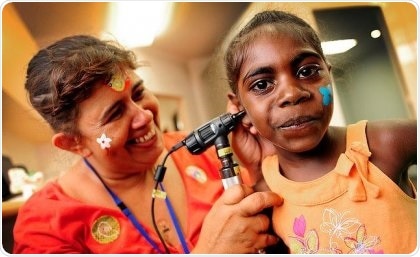The main cause of preventable hearing loss and deafness in Indigenous communities is chronic middle ear infections. This issue can be overcome with the help of bacteria found in the upper respiratory system of children.

Bacteria could help fight chronic middle ear infections. Image Credit: Australian Department of Health.
According to Dr. Seweryn Bialasiewicz from The University of Queensland, this breakthrough enables explaining a long-held mystery, while offering hope for promising therapies.
“We’ve been puzzled for years now, trying to work out why some children never develop chronic ear disease, despite being in a high-risk category for contracting it,” stated Dr. Bialasiewicz.
By focusing on the microbiomes in the upper respiratory tracts of disease-resistant kids, we could investigate the ecological networks of bacterial interactions that seemed to be working together to protect against the condition. It was clear that these two groups of bacteria needed to not only be present, but to be interacting with each other, to provide protection from middle ear infections.”
Dr Seweryn Bialasiewicz, The University of Queensland
Dr. Bialasiewicz added that they looking to use this information to find the precise mechanism of protection and then simulate it in very young children, as a treatment or a preventative measure.
This could take the form of a molecule that can be used as a drug for treatment, or as a protective probiotic so that these ‘good’ bacteria can be seeded in the nose early enough to offer protection against the incoming ‘bad’ bacteria.”
Dr Seweryn Bialasiewicz, The University of Queensland
According to Dr. Andrea Coleman, who completed her Ph.D. study on the project this year, the study offered a completely new point of view on how middle ear infections occur and could open the door for new treatments.
Chronic middle ear infections can affect between one third to one half of Aboriginal and Torres Strait Islander children, which is far above the four per cent threshold that the World Health Organisation considers as a disease needing urgent public health action.”
Dr Andrea Coleman, The University of Queensland
“This disease can cause hearing loss and can have life-long impacts on speech and language development, education, and future employment prospects, and in Aboriginal and Torres Strait Islander populations contributes to the wide gap in educational and employment outcomes,” added Dr. Coleman.
The research analyzed the microbiomes of 103 children aged between two and seven from two north Queensland communities. Dr. Bialasiewicz added that chronic middle ear infections leading to hearing loss were a major issue with Indigenous and other underprivileged populations across the globe.
“Our discovery could be applied across the world, helping improve health and reducing the disadvantage gap for a wide range of people,” Dr. Bialasiewicz concluded.
Source:
Journal reference:
Coleman, A., et al. (2021) Upper Respiratory Tract Microbiome of Australian Aboriginal and Torres Strait Islander Children in Ear and Nose Health and Disease. Microbiology Spectrum. doi.org/10.1128/Spectrum.00367-21.